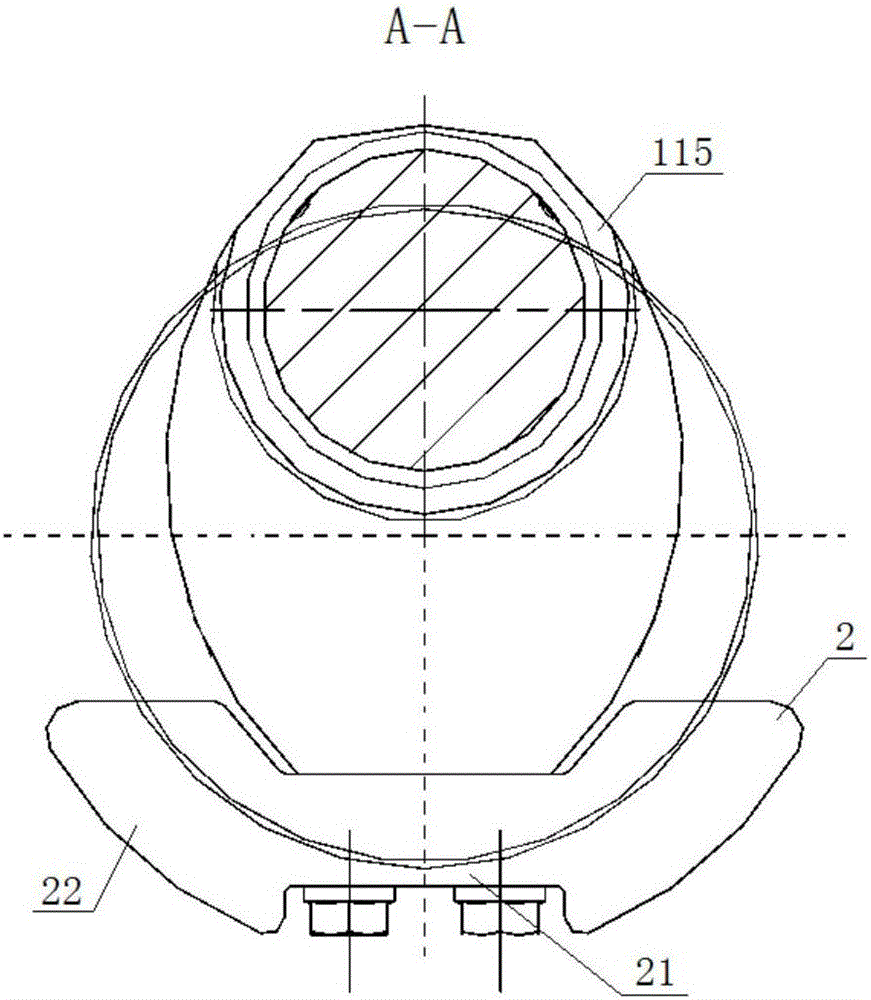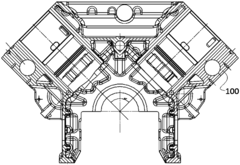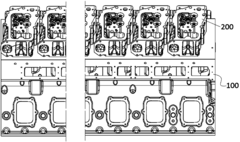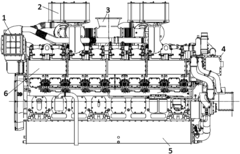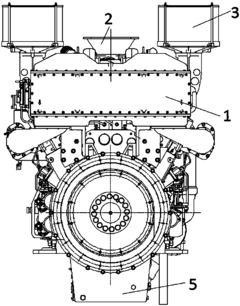V16 engines in motorsports: legacy, limitations, and historical milestones
AUG 15, 20259 MIN READ
Generate Your Research Report Instantly with AI Agent
Patsnap Eureka helps you evaluate technical feasibility & market potential.
V16 Engine Evolution
The evolution of V16 engines in motorsports represents a fascinating journey through automotive engineering history. These powerful and complex powerplants first emerged in the 1930s, marking a significant milestone in the pursuit of maximum performance on the racetrack. The initial development of V16 engines was driven by the desire to achieve higher power outputs while maintaining a relatively compact design.
In the early stages, manufacturers like Auto Union and BRM (British Racing Motors) pioneered the use of V16 engines in Grand Prix racing. Auto Union's Type C, introduced in 1936, featured a 6.0-liter V16 engine that produced an impressive 520 horsepower. This engine showcased the potential of the V16 configuration to deliver exceptional power-to-weight ratios, a crucial factor in motorsports.
The post-World War II era saw renewed interest in V16 engines, with BRM's ambitious project to create a 1.5-liter supercharged V16 for Formula One. Unveiled in 1950, the BRM V16 engine was a marvel of engineering, capable of revving up to 12,000 RPM and producing over 600 horsepower. However, it also highlighted the challenges associated with V16 engines, including complexity, reliability issues, and high fuel consumption.
As motorsport regulations evolved, particularly in Formula One, the emphasis shifted towards smaller, more efficient engines. This change led to a decline in the use of V16 engines in top-tier racing. The last notable appearance of a V16 engine in Formula One was the BRM P15, which competed in the early 1950s.
Despite their limited success in competitive racing, V16 engines left an indelible mark on motorsport history. They pushed the boundaries of engine design and performance, inspiring future developments in high-performance engines. The legacy of V16 engines can be seen in the continuous pursuit of power and efficiency in modern motorsport, albeit through different technological approaches.
In recent years, there has been a resurgence of interest in V16 engines, primarily in the realm of luxury and concept vehicles. While not directly related to motorsports, this renewed focus demonstrates the enduring fascination with the V16 configuration. These modern interpretations often combine traditional V16 architecture with cutting-edge technologies, showcasing the potential for innovation within this historic engine design.
The evolution of V16 engines in motorsports serves as a testament to the relentless pursuit of performance and the willingness of engineers to explore unconventional solutions. While their practical application in modern racing has diminished, the impact of V16 engines on automotive engineering and the motorsport industry remains significant, continuing to inspire and influence engine design philosophies to this day.
In the early stages, manufacturers like Auto Union and BRM (British Racing Motors) pioneered the use of V16 engines in Grand Prix racing. Auto Union's Type C, introduced in 1936, featured a 6.0-liter V16 engine that produced an impressive 520 horsepower. This engine showcased the potential of the V16 configuration to deliver exceptional power-to-weight ratios, a crucial factor in motorsports.
The post-World War II era saw renewed interest in V16 engines, with BRM's ambitious project to create a 1.5-liter supercharged V16 for Formula One. Unveiled in 1950, the BRM V16 engine was a marvel of engineering, capable of revving up to 12,000 RPM and producing over 600 horsepower. However, it also highlighted the challenges associated with V16 engines, including complexity, reliability issues, and high fuel consumption.
As motorsport regulations evolved, particularly in Formula One, the emphasis shifted towards smaller, more efficient engines. This change led to a decline in the use of V16 engines in top-tier racing. The last notable appearance of a V16 engine in Formula One was the BRM P15, which competed in the early 1950s.
Despite their limited success in competitive racing, V16 engines left an indelible mark on motorsport history. They pushed the boundaries of engine design and performance, inspiring future developments in high-performance engines. The legacy of V16 engines can be seen in the continuous pursuit of power and efficiency in modern motorsport, albeit through different technological approaches.
In recent years, there has been a resurgence of interest in V16 engines, primarily in the realm of luxury and concept vehicles. While not directly related to motorsports, this renewed focus demonstrates the enduring fascination with the V16 configuration. These modern interpretations often combine traditional V16 architecture with cutting-edge technologies, showcasing the potential for innovation within this historic engine design.
The evolution of V16 engines in motorsports serves as a testament to the relentless pursuit of performance and the willingness of engineers to explore unconventional solutions. While their practical application in modern racing has diminished, the impact of V16 engines on automotive engineering and the motorsport industry remains significant, continuing to inspire and influence engine design philosophies to this day.
Motorsport Market Demand
The motorsport market has consistently demonstrated a robust demand for high-performance engines, with V16 configurations holding a special place in racing history. Despite their limited use in modern motorsports, V16 engines continue to captivate enthusiasts and engineers alike, driving a niche but passionate market segment.
Historically, the demand for V16 engines in motorsports peaked during the 1930s and early 1950s, particularly in Grand Prix racing. This era saw manufacturers like Auto Union and BRM pushing the boundaries of engine design to gain competitive advantages. The allure of V16 engines stemmed from their potential for high power output and smooth operation, qualities highly prized in top-tier racing.
However, the market for V16 engines in motorsports has significantly diminished since their heyday. This decline can be attributed to several factors, including changes in racing regulations, advancements in engine technology, and the increasing focus on efficiency and sustainability in motorsports. Modern racing series, such as Formula 1, have moved towards smaller displacement engines with fewer cylinders, effectively eliminating the demand for V16 configurations in top-level competitions.
Despite this shift, there remains a persistent interest in V16 engines within certain segments of the motorsport market. Vintage and historic racing events continue to showcase these engineering marvels, attracting enthusiasts and collectors. This niche market supports restoration projects, replica builds, and the maintenance of existing V16-powered race cars, sustaining a small but dedicated industry.
The legacy of V16 engines also influences contemporary engine design and development in motorsports. While not directly applied, the lessons learned from V16 configurations inform current engine technologies, particularly in areas such as power density, thermal management, and vibration control. This historical knowledge contributes to the ongoing evolution of racing engines, indirectly shaping market demands for high-performance powertrains.
Looking forward, the motorsport market's demand for V16 engines is likely to remain limited to specialized applications and historical recreations. However, the principles and innovations derived from V16 engine development continue to influence the broader motorsport engine market. As the industry evolves towards more sustainable technologies, the legacy of V16 engines serves as a benchmark for power and performance, inspiring new approaches to engine design that balance performance with efficiency and environmental considerations.
Historically, the demand for V16 engines in motorsports peaked during the 1930s and early 1950s, particularly in Grand Prix racing. This era saw manufacturers like Auto Union and BRM pushing the boundaries of engine design to gain competitive advantages. The allure of V16 engines stemmed from their potential for high power output and smooth operation, qualities highly prized in top-tier racing.
However, the market for V16 engines in motorsports has significantly diminished since their heyday. This decline can be attributed to several factors, including changes in racing regulations, advancements in engine technology, and the increasing focus on efficiency and sustainability in motorsports. Modern racing series, such as Formula 1, have moved towards smaller displacement engines with fewer cylinders, effectively eliminating the demand for V16 configurations in top-level competitions.
Despite this shift, there remains a persistent interest in V16 engines within certain segments of the motorsport market. Vintage and historic racing events continue to showcase these engineering marvels, attracting enthusiasts and collectors. This niche market supports restoration projects, replica builds, and the maintenance of existing V16-powered race cars, sustaining a small but dedicated industry.
The legacy of V16 engines also influences contemporary engine design and development in motorsports. While not directly applied, the lessons learned from V16 configurations inform current engine technologies, particularly in areas such as power density, thermal management, and vibration control. This historical knowledge contributes to the ongoing evolution of racing engines, indirectly shaping market demands for high-performance powertrains.
Looking forward, the motorsport market's demand for V16 engines is likely to remain limited to specialized applications and historical recreations. However, the principles and innovations derived from V16 engine development continue to influence the broader motorsport engine market. As the industry evolves towards more sustainable technologies, the legacy of V16 engines serves as a benchmark for power and performance, inspiring new approaches to engine design that balance performance with efficiency and environmental considerations.
Technical Challenges
V16 engines in motorsports have faced numerous technical challenges throughout their history, limiting their widespread adoption and long-term viability. One of the primary obstacles has been the engine's sheer size and complexity. With 16 cylinders arranged in a linear or V-configuration, these engines require significantly more space than their V8 or V12 counterparts, making them difficult to integrate into streamlined racing car designs.
The increased number of moving parts in V16 engines also presents reliability concerns. More cylinders mean more potential points of failure, including pistons, valves, and connecting rods. This complexity not only increases the likelihood of mechanical issues but also makes maintenance and repairs more time-consuming and costly, a critical factor in the fast-paced world of motorsports.
Weight distribution has been another significant challenge for V16 engines. The additional mass of these larger engines can negatively impact a vehicle's handling characteristics, particularly in terms of cornering and overall balance. This issue becomes even more pronounced in racing scenarios where every fraction of a second counts, and optimal weight distribution is crucial for achieving peak performance.
Fuel efficiency has also posed a considerable hurdle for V16 engines in motorsports. The increased number of cylinders typically results in higher fuel consumption, which can be a major disadvantage in endurance racing events where fuel management is critical. This inefficiency not only affects race strategy but also conflicts with the growing emphasis on sustainability and environmental consciousness in modern motorsports.
Heat management represents another technical challenge associated with V16 engines. The greater number of combustion chambers generates significantly more heat than smaller engines, requiring advanced cooling systems to prevent overheating and maintain optimal performance. This additional cooling requirement often leads to increased weight and complexity in the overall vehicle design.
From a regulatory standpoint, V16 engines have faced challenges in meeting increasingly stringent emissions standards and engine capacity limitations imposed by various racing organizations. These regulations, aimed at promoting competition and reducing costs, have often favored smaller, more efficient engine configurations, further marginalizing the use of V16 engines in top-tier motorsports.
Lastly, the development and production costs associated with V16 engines have been a significant barrier to their widespread adoption. The intricate design, specialized components, and limited production runs make these engines extremely expensive to manufacture and maintain, often outweighing their potential performance benefits in the highly competitive and cost-conscious world of motorsports.
The increased number of moving parts in V16 engines also presents reliability concerns. More cylinders mean more potential points of failure, including pistons, valves, and connecting rods. This complexity not only increases the likelihood of mechanical issues but also makes maintenance and repairs more time-consuming and costly, a critical factor in the fast-paced world of motorsports.
Weight distribution has been another significant challenge for V16 engines. The additional mass of these larger engines can negatively impact a vehicle's handling characteristics, particularly in terms of cornering and overall balance. This issue becomes even more pronounced in racing scenarios where every fraction of a second counts, and optimal weight distribution is crucial for achieving peak performance.
Fuel efficiency has also posed a considerable hurdle for V16 engines in motorsports. The increased number of cylinders typically results in higher fuel consumption, which can be a major disadvantage in endurance racing events where fuel management is critical. This inefficiency not only affects race strategy but also conflicts with the growing emphasis on sustainability and environmental consciousness in modern motorsports.
Heat management represents another technical challenge associated with V16 engines. The greater number of combustion chambers generates significantly more heat than smaller engines, requiring advanced cooling systems to prevent overheating and maintain optimal performance. This additional cooling requirement often leads to increased weight and complexity in the overall vehicle design.
From a regulatory standpoint, V16 engines have faced challenges in meeting increasingly stringent emissions standards and engine capacity limitations imposed by various racing organizations. These regulations, aimed at promoting competition and reducing costs, have often favored smaller, more efficient engine configurations, further marginalizing the use of V16 engines in top-tier motorsports.
Lastly, the development and production costs associated with V16 engines have been a significant barrier to their widespread adoption. The intricate design, specialized components, and limited production runs make these engines extremely expensive to manufacture and maintain, often outweighing their potential performance benefits in the highly competitive and cost-conscious world of motorsports.
Current V16 Solutions
01 V16 engine design and configuration
V16 engines are large, powerful internal combustion engines with 16 cylinders arranged in a V-shape. These engines are typically used in high-performance vehicles, marine applications, and industrial machinery. The V-configuration allows for a more compact design compared to inline engines, while still providing significant power output.- V16 engine design and configuration: V16 engines are large, powerful internal combustion engines with 16 cylinders arranged in a V-shape. This configuration allows for increased power output while maintaining a relatively compact design compared to inline engines of similar displacement. V16 engines are often used in high-performance vehicles, marine applications, and industrial machinery.
- V16 engine applications in vehicles: V16 engines are utilized in various types of vehicles, including luxury cars, racing cars, and heavy-duty trucks. These engines provide exceptional power and torque, making them suitable for high-performance applications and heavy load-bearing vehicles. The implementation of V16 engines in vehicles often requires specialized design considerations for cooling, lubrication, and exhaust systems.
- V16 engine control systems: Advanced control systems are crucial for optimizing the performance and efficiency of V16 engines. These systems may include electronic fuel injection, variable valve timing, and engine management computers. Control systems help manage the complex operations of V16 engines, ensuring proper fuel delivery, ignition timing, and overall engine performance.
- V16 engine cooling and lubrication: Effective cooling and lubrication systems are essential for V16 engines due to their high power output and complex design. These systems may include advanced coolant circulation, oil pumps, and heat exchangers to maintain optimal operating temperatures and reduce wear on engine components. Proper cooling and lubrication are critical for ensuring the longevity and reliability of V16 engines.
- V16 engine manufacturing and assembly: The manufacturing and assembly of V16 engines require specialized processes and equipment due to their complexity and size. This may involve precision machining of engine blocks, crankshafts, and cylinder heads, as well as advanced assembly techniques to ensure proper alignment and fitment of components. Quality control measures are crucial throughout the manufacturing process to maintain the high performance standards of V16 engines.
02 V16 engine applications in vehicles
V16 engines are often employed in luxury and high-performance automobiles, as well as in some specialized vehicles such as military tanks and large trucks. These engines provide exceptional power and torque, making them suitable for heavy-duty applications and high-speed performance vehicles.Expand Specific Solutions03 V16 engine control systems
Advanced control systems are crucial for managing the complex operations of V16 engines. These systems may include electronic fuel injection, variable valve timing, and sophisticated engine management computers to optimize performance, fuel efficiency, and emissions control.Expand Specific Solutions04 Historical development of V16 engines
The development of V16 engines dates back to the early 20th century, with various designs and improvements made over the years. Early applications included aircraft engines and luxury automobiles. The evolution of V16 engines has led to increased power output, improved efficiency, and enhanced reliability.Expand Specific Solutions05 V16 engine cooling and lubrication systems
Due to their large size and high power output, V16 engines require sophisticated cooling and lubrication systems. These may include advanced oil circulation methods, multiple radiators, and efficient coolant flow designs to maintain optimal operating temperatures and ensure longevity of engine components.Expand Specific Solutions
Key Manufacturers
The V16 engine market in motorsports represents a niche segment within the broader automotive industry, characterized by high-performance and specialized applications. Currently, the market is in a mature phase, with limited growth potential due to evolving regulations and technological shifts towards more efficient and environmentally friendly powertrains. The market size for V16 engines in motorsports is relatively small, catering primarily to high-end racing categories and luxury vehicle segments. Technologically, V16 engines are highly advanced, with companies like Honda Motor Co., Ltd., BMW AG, and Yamaha Motor Co., Ltd. leading in research and development. However, the focus is shifting towards hybrid and electric powertrains, potentially limiting future growth for traditional V16 engines in motorsports.
Honda Motor Co., Ltd.
Technical Solution: Honda has been a major player in motorsports for decades, although they have not specifically focused on V16 engines. Their most relevant experience to the V16 legacy is their involvement in Formula 1, where they have developed high-performance engines since the 1960s. Honda's RA271 V12 engine from 1964 was a precursor to larger, more powerful designs[5]. While not a V16, it showcased Honda's capability in creating complex, high-cylinder count engines for motorsports. In recent years, Honda has focused on turbocharged V6 engines for F1, demonstrating their ability to adapt to changing regulations and technological trends in racing[6].
Strengths: Extensive experience in high-performance engine development for various motorsport categories. Weaknesses: No direct experience with V16 engines in competitive racing, current focus on smaller, turbocharged engines.
Bayerische Motoren Werke AG
Technical Solution: BMW, while not known for V16 engines in motorsports, has a significant presence in racing with other engine configurations. Their most relevant contribution to the V16 legacy is the BMW 767 engine, a 6.0-liter V16 developed in the 1980s for Formula 1. Although it never raced, it demonstrated BMW's capability in creating high-performance, large-displacement engines[3]. BMW's current motorsport focus is on smaller, turbocharged engines, reflecting the industry trend towards efficiency. They have successfully competed in various motorsport categories, including Formula E, demonstrating their adaptability to changing technological demands in racing[4].
Strengths: Proven track record in motorsports, experience with high-performance engine development. Weaknesses: Limited direct experience with V16 engines in competitive racing, current focus on smaller, more efficient engines.
Core V16 Innovations
Crankshaft structure of V-shaped 16-cylinder engine
PatentInactiveCN106089974A
Innovation
- A V-shaped 16-cylinder engine crankshaft structure is designed, using horizontal and vertical oil passage arrangements on multiple cranks and connecting rod journals, combined with symmetrical crank arms and counterweights, to optimize the oil passage arrangement and firing sequence. , enhanced lubrication effect and dynamic balance.
High-power V16 diesel engine
PatentActiveCN108194198A
Innovation
- A high-power V-shaped 16-cylinder diesel engine is designed, which uses a V-shaped cylinder block, 16 single cylinder heads, four turbochargers and an intercooler, combined with a cooling system of high and low temperature water circulation loops, to achieve turbocharging through Technology and classified cooling systems increase air density and lower temperatures to meet the needs of high power and torque.
Regulatory Framework
The regulatory framework surrounding V16 engines in motorsports has played a crucial role in shaping their legacy, limitations, and historical milestones. Throughout the history of motorsports, governing bodies have implemented various rules and regulations that have directly impacted the development and use of V16 engines.
In the early days of motorsport, regulations were relatively lax, allowing for the development of powerful and innovative engines like the V16. The 1930s saw the rise of these engines in Grand Prix racing, with manufacturers like Auto Union and BRM pushing the boundaries of engine design. However, as motorsports evolved, regulatory bodies began to implement stricter guidelines to ensure safety, promote competition, and control costs.
One of the most significant regulatory changes came in the form of engine displacement limitations. Governing bodies such as the FIA (Fédération Internationale de l'Automobile) introduced rules that restricted engine sizes, effectively phasing out larger engines like the V16. These regulations forced manufacturers to focus on smaller, more efficient engine designs, leading to the decline of V16 engines in top-tier motorsports.
Fuel consumption regulations also played a role in shaping the use of V16 engines. As environmental concerns grew, motorsport organizations implemented fuel efficiency standards, which posed challenges for the notoriously thirsty V16 engines. This shift in focus towards more fuel-efficient powertrains further limited the viability of V16 engines in competitive racing.
Safety regulations have also indirectly affected the use of V16 engines. As motorsports governing bodies implemented stricter safety standards, the overall design of race cars had to evolve. This often meant reducing the size and weight of vehicles, which in turn made it more challenging to accommodate large, complex engines like the V16.
The introduction of homologation rules in various racing series further impacted the development of V16 engines. These regulations required manufacturers to produce a certain number of road-going versions of their race cars, making it economically unfeasible to develop specialized engines solely for racing purposes.
In recent years, the regulatory framework has continued to evolve, with a growing emphasis on sustainability and cost control. Many racing series have introduced hybrid powertrains and energy recovery systems, further shifting the focus away from traditional high-displacement engines like the V16.
Despite these regulatory challenges, the legacy of V16 engines in motorsports remains significant. Their development and use have left an indelible mark on the history of racing, showcasing the pinnacle of engineering prowess and pushing the boundaries of what was possible in automotive technology.
In the early days of motorsport, regulations were relatively lax, allowing for the development of powerful and innovative engines like the V16. The 1930s saw the rise of these engines in Grand Prix racing, with manufacturers like Auto Union and BRM pushing the boundaries of engine design. However, as motorsports evolved, regulatory bodies began to implement stricter guidelines to ensure safety, promote competition, and control costs.
One of the most significant regulatory changes came in the form of engine displacement limitations. Governing bodies such as the FIA (Fédération Internationale de l'Automobile) introduced rules that restricted engine sizes, effectively phasing out larger engines like the V16. These regulations forced manufacturers to focus on smaller, more efficient engine designs, leading to the decline of V16 engines in top-tier motorsports.
Fuel consumption regulations also played a role in shaping the use of V16 engines. As environmental concerns grew, motorsport organizations implemented fuel efficiency standards, which posed challenges for the notoriously thirsty V16 engines. This shift in focus towards more fuel-efficient powertrains further limited the viability of V16 engines in competitive racing.
Safety regulations have also indirectly affected the use of V16 engines. As motorsports governing bodies implemented stricter safety standards, the overall design of race cars had to evolve. This often meant reducing the size and weight of vehicles, which in turn made it more challenging to accommodate large, complex engines like the V16.
The introduction of homologation rules in various racing series further impacted the development of V16 engines. These regulations required manufacturers to produce a certain number of road-going versions of their race cars, making it economically unfeasible to develop specialized engines solely for racing purposes.
In recent years, the regulatory framework has continued to evolve, with a growing emphasis on sustainability and cost control. Many racing series have introduced hybrid powertrains and energy recovery systems, further shifting the focus away from traditional high-displacement engines like the V16.
Despite these regulatory challenges, the legacy of V16 engines in motorsports remains significant. Their development and use have left an indelible mark on the history of racing, showcasing the pinnacle of engineering prowess and pushing the boundaries of what was possible in automotive technology.
Environmental Impact
The environmental impact of V16 engines in motorsports has been a subject of increasing concern in recent years. These powerful engines, while renowned for their performance and historical significance, have faced scrutiny due to their high fuel consumption and emissions output. The large displacement and complex design of V16 engines typically result in greater fuel consumption compared to smaller engine configurations, leading to increased carbon dioxide emissions per kilometer driven.
In the context of motorsports, the environmental footprint extends beyond just the races themselves. The manufacturing process of these specialized engines, often involving rare materials and energy-intensive production methods, contributes to their overall environmental impact. Additionally, the transportation of these engines and associated equipment to various racing venues around the world adds to their carbon footprint.
The noise pollution generated by V16 engines is another environmental consideration. While the distinctive sound of these engines is often celebrated by motorsport enthusiasts, it can have negative effects on local ecosystems and communities near racing circuits. This has led to increased pressure on motorsport organizations to implement noise reduction measures and limit the use of such high-powered engines in certain events.
As environmental awareness has grown, many motorsport governing bodies have introduced regulations aimed at reducing the environmental impact of racing. These measures have often targeted engine specifications, including limitations on engine size and fuel consumption. Such regulations have played a significant role in the decline of V16 engines in modern motorsports, as teams and manufacturers have shifted towards more fuel-efficient and environmentally friendly engine designs.
The legacy of V16 engines in motorsports, however, has inspired innovations in engine technology that have broader applications. Research and development in areas such as fuel efficiency, materials science, and aerodynamics, initially driven by the quest for performance in V16 and other high-powered engines, have led to advancements that benefit more environmentally friendly automotive technologies. This transfer of knowledge from motorsports to everyday vehicles has contributed to improvements in fuel economy and emissions reduction in consumer automobiles.
Looking towards the future, the environmental impact of V16 engines serves as a catalyst for the development of sustainable motorsport technologies. This includes the exploration of alternative fuels, hybrid powertrains, and even fully electric racing vehicles. While these advancements may signal the end of the V16 era in competitive motorsports, they also represent the industry's adaptation to global environmental challenges and its potential to drive innovation in sustainable transportation technologies.
In the context of motorsports, the environmental footprint extends beyond just the races themselves. The manufacturing process of these specialized engines, often involving rare materials and energy-intensive production methods, contributes to their overall environmental impact. Additionally, the transportation of these engines and associated equipment to various racing venues around the world adds to their carbon footprint.
The noise pollution generated by V16 engines is another environmental consideration. While the distinctive sound of these engines is often celebrated by motorsport enthusiasts, it can have negative effects on local ecosystems and communities near racing circuits. This has led to increased pressure on motorsport organizations to implement noise reduction measures and limit the use of such high-powered engines in certain events.
As environmental awareness has grown, many motorsport governing bodies have introduced regulations aimed at reducing the environmental impact of racing. These measures have often targeted engine specifications, including limitations on engine size and fuel consumption. Such regulations have played a significant role in the decline of V16 engines in modern motorsports, as teams and manufacturers have shifted towards more fuel-efficient and environmentally friendly engine designs.
The legacy of V16 engines in motorsports, however, has inspired innovations in engine technology that have broader applications. Research and development in areas such as fuel efficiency, materials science, and aerodynamics, initially driven by the quest for performance in V16 and other high-powered engines, have led to advancements that benefit more environmentally friendly automotive technologies. This transfer of knowledge from motorsports to everyday vehicles has contributed to improvements in fuel economy and emissions reduction in consumer automobiles.
Looking towards the future, the environmental impact of V16 engines serves as a catalyst for the development of sustainable motorsport technologies. This includes the exploration of alternative fuels, hybrid powertrains, and even fully electric racing vehicles. While these advancements may signal the end of the V16 era in competitive motorsports, they also represent the industry's adaptation to global environmental challenges and its potential to drive innovation in sustainable transportation technologies.
Unlock deeper insights with Patsnap Eureka Quick Research — get a full tech report to explore trends and direct your research. Try now!
Generate Your Research Report Instantly with AI Agent
Supercharge your innovation with Patsnap Eureka AI Agent Platform!


